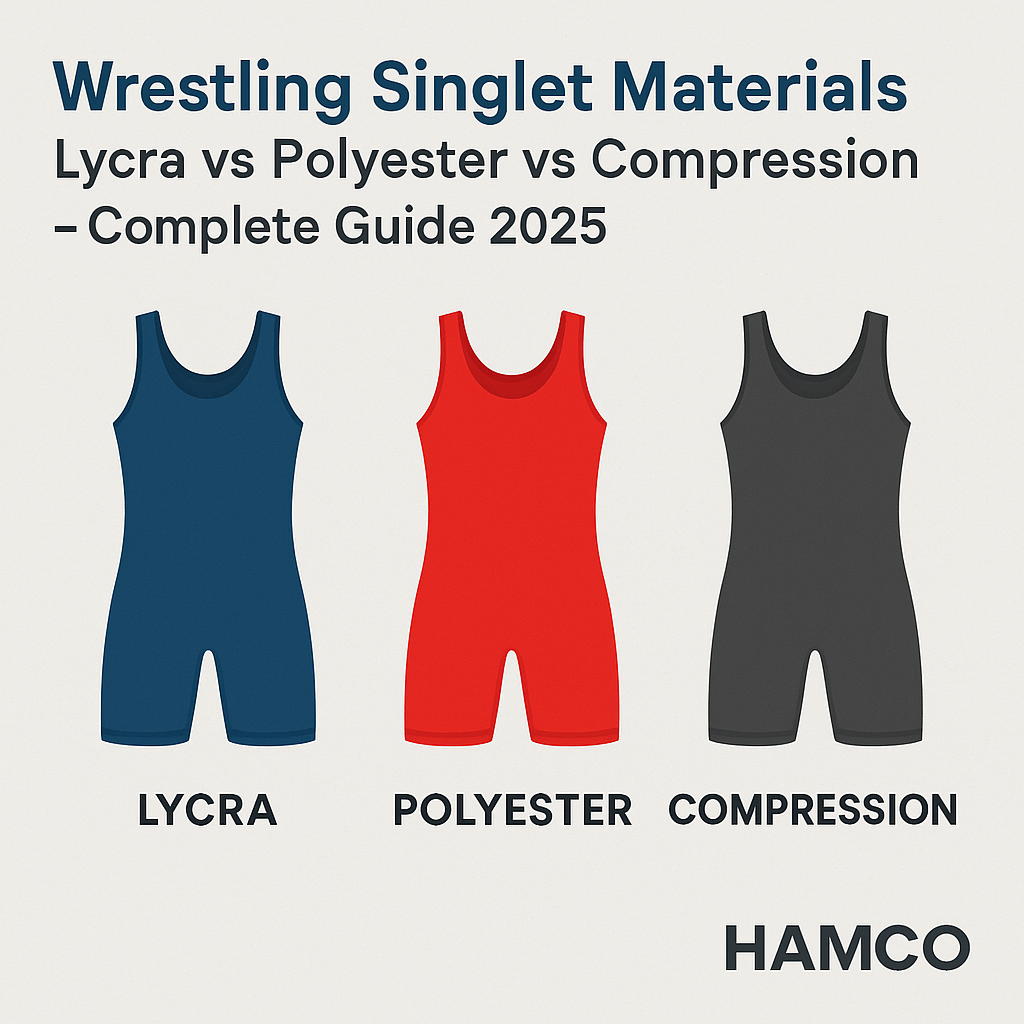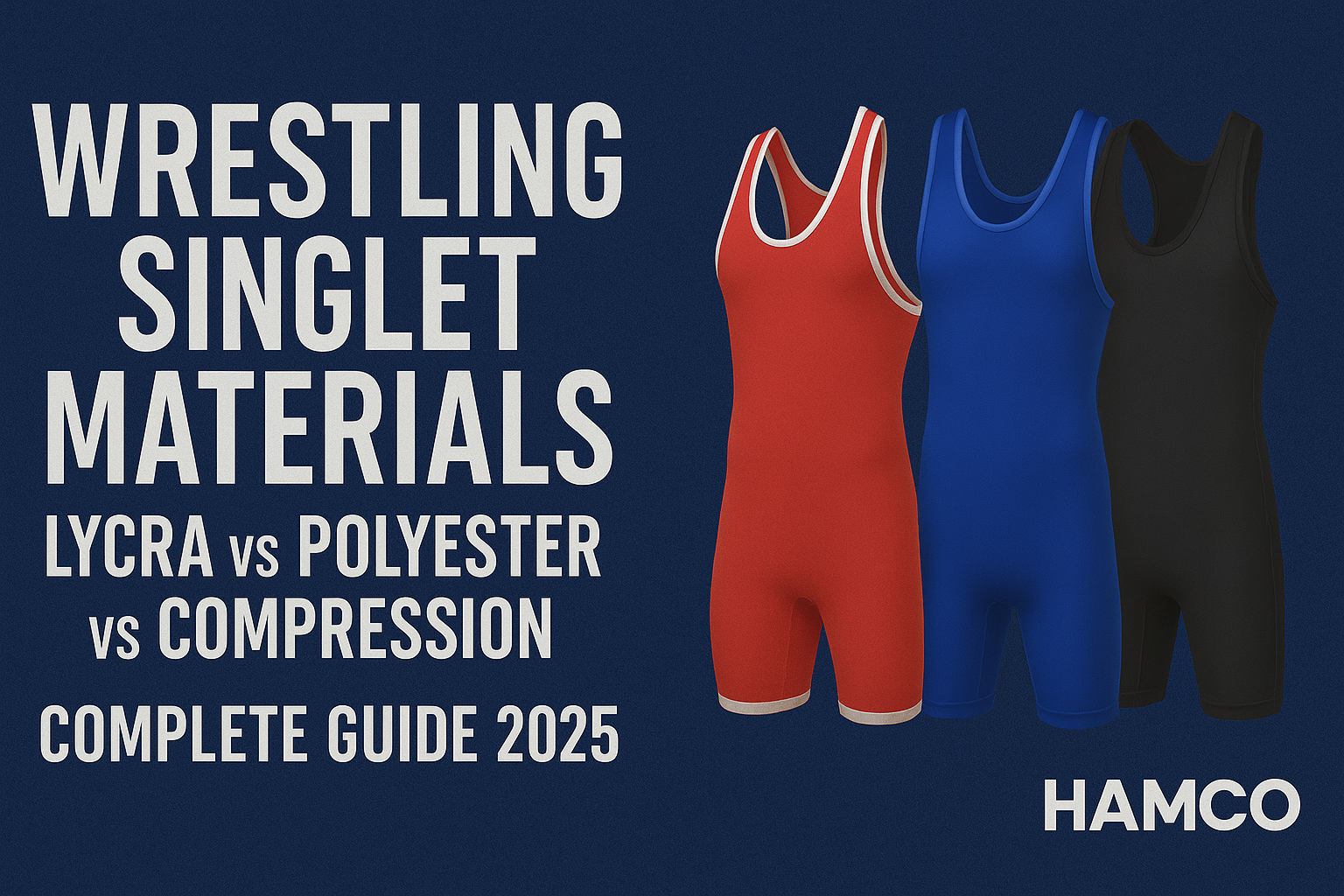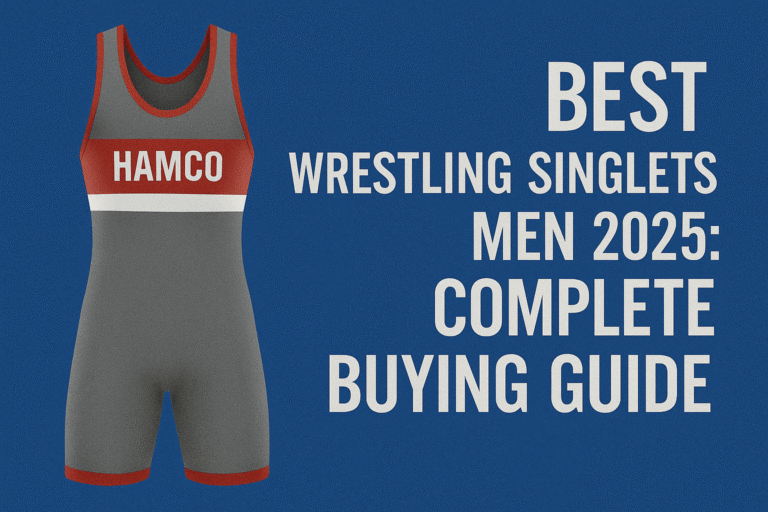
Introduction
Choosing the right wrestling singlet materials can make the difference between a championship performance and an uncomfortable match. Whether you’re outfitting a youth wrestling club, high school varsity team, or collegiate program, understanding the properties of different singlet materials is crucial for athlete comfort, performance, and safety. Today’s singlet materials have evolved far beyond basic cotton blends, incorporating advanced synthetic fibers and performance technologies that enhance every aspect of competition.
Our Track Record: Since 2011, Hamco Sports has produced over 25,000 wrestling singlets using various material combinations. Our expertise in singlet materials comes from working with 850+ teams across the United States, testing fabric performance in real competition conditions. We’ve mastered the science of selecting and combining singlet materials to create uniforms that perform under pressure while maintaining comfort throughout tournaments.
This comprehensive guide examines the three primary categories of singlet materials: Lycra blends, polyester compositions, and compression fabrics. You’ll discover how each material performs in terms of stretch, recovery, durability, and moisture management. We’ll also explore the latest innovations in wrestling singlet materials for 2025, including antimicrobial treatments and smart textile technologies that are revolutionizing the sport.
Understanding Wrestling Singlet Material Basics
The Evolution of Wrestling Fabrics
The journey of singlet materials began with heavy cotton uniforms that absorbed sweat and restricted movement. These early materials were unsuitable for the sport’s demanding physical requirements, often becoming waterlogged and stretched out during matches. The introduction of synthetic wrestling singlet materials in the 1960s marked a revolutionary shift, with nylon becoming the first synthetic fiber widely adopted for wrestling uniforms.
Modern wrestling singlet materials are engineered specifically for the unique demands of wrestling competition. Today’s fabrics must provide four-way stretch to accommodate extreme positions, moisture-wicking properties to manage perspiration, and durability to withstand grabbing and pulling. The most common singlet materials now include polyester-spandex blends (typically 88-90% polyester, 10-12% spandex), pure Lycra compositions, and specialized compression fabrics that combine multiple synthetic fibers for optimal performance.
The science behind wrestling singlet materials has advanced significantly with the development of microfiber technology and molecular-level fabric engineering. These innovations allow manufacturers to create wrestling singlet materials that are lighter, stronger, and more responsive than ever before. Modern singlets typically weigh between 200-280 GSM (grams per square meter), providing the perfect balance between durability and flexibility that wrestlers need for peak performance.
Material Requirements for Competition
Competition-approved singlet materials must meet specific standards set by governing bodies like USA Wrestling and the National Federation of State High School Associations. These organizations specify that singlet materials must be non-abrasive, provide adequate coverage, and maintain their shape throughout matches. The materials cannot be excessively slippery or include any elements that could provide an unfair advantage or safety hazard.
By the Numbers – Material Performance Statistics:
- Stretch capability: 150-200% of original size
- Recovery rate: 95-98% return to original shape
- Moisture absorption: Less than 0.5% of fabric weight
- Durability: 2-4 seasons with proper care
- Weight range: 200-280 GSM for competition singlets
Lycra: The Premium Stretch Option
Understanding Lycra Technology
Lycra, also known as spandex or elastane, represents the gold standard in wrestling singlet materials for stretch and recovery. Developed by DuPont in 1958, Lycra revolutionized athletic wear with its ability to stretch up to 500% of its original length while maintaining complete shape recovery. In wrestling singlet materials, Lycra is typically blended with polyester or nylon at ratios of 10-20% to create fabrics that move seamlessly with the athlete’s body.
The molecular structure of Lycra in wrestling singlet materials consists of long-chain polymer fibers that act like microscopic springs. This unique construction allows the material to stretch in all directions while providing consistent compression and support. When used in wrestling singlet materials, Lycra creates a second-skin fit that eliminates excess fabric opponents could grab while maintaining comfort during extreme movements like bridges, sprawls, and escapes.
Performance Characteristics of Lycra Blends
Wrestling singlet materials containing Lycra offer superior performance in several key areas. The four-way stretch capability allows wrestlers to achieve full range of motion without restriction, crucial for executing complex techniques. The compression properties of Lycra-based wrestling singlet materials provide muscle support that can reduce fatigue and improve proprioception – the body’s ability to sense its position in space.
| Material Blend | Stretch % | Recovery Rate | Durability | Durability | Best For |
| 82% Nylon/18% Lycra | 180-200% | 98% | Excellent | $35-45 | Elite Competition |
| 80% Polyester/20% Lycra | 170-190% | 97% | Very Good | $30-40 | All Levels |
| 88% Polyester/12% Lycra | 150-170% | 96% | Good | $25-35 | Training/Competition |
| 90% Polyester/10% Lycra | 140-160% | 95% | Good | $25-30 | Youth/Recreational |
Advantages and Considerations
Lycra-based singlet materials excel in comfort and performance, providing unmatched flexibility and shape retention. The material’s moisture-wicking properties keep wrestlers dry during intense matches, while the smooth surface reduces friction burns from mat contact. Our most popular wrestling singlet materials blend – 90% polyester with 10% spandex at 260 GSM – offers the ideal balance of stretch, durability, and affordability that most teams seek.
However, pure Lycra singlet materials require specific care to maintain their properties. High heat from dryers can damage the elastic fibers, reducing stretch and recovery over time. The material is also more susceptible to snagging on rough surfaces compared to pure polyester options. Despite these considerations, Lycra remains the preferred choice for singlet materials among serious competitors who prioritize performance and comfort.
Polyester: The Durable Workhorse
Polyester Fabric Technology
Polyester dominates the wrestling singlet materials market due to its exceptional durability and versatility. This synthetic polymer fiber, first developed in the 1940s, offers unique properties that make it ideal for athletic wear. In singlet materials, polyester provides excellent strength-to-weight ratio, color retention, and resistance to stretching and shrinking. Modern polyester singlet materials incorporate advanced weaving techniques that enhance breathability while maintaining structural integrity.
The molecular structure of polyester in singlet materials creates a hydrophobic surface that repels water rather than absorbing it. This characteristic is crucial for moisture management during wrestling matches, as the fabric quickly transfers sweat to the outer surface for evaporation. High-quality polyester wrestling singlet materials can wick moisture 30% faster than cotton and dry in half the time, keeping wrestlers comfortable throughout extended tournament days.
Performance Benefits of Polyester Blends
Wrestling singlet materials utilizing polyester blends offer consistent performance across various conditions. The fiber’s inherent strength means these singlets maintain their shape even after repeated washing and wearing. Polyester singlet materials also excel in color vibrancy and design retention, making them ideal for sublimation printing. Teams can incorporate complex graphics and vibrant colors without worrying about fading or deterioration.
Modern polyester wrestling singlet materials often incorporate microfiber technology, creating fabrics that are softer and more breathable than traditional polyester. These advanced materials feature fiber diameters less than one denier, resulting in singlet materials that feel luxurious against the skin while maintaining the durability polyester is known for. The tighter weave of microfiber polyester also provides better compression and support compared to standard polyester fabrics.
Cost-Effectiveness and Longevity
One of the primary advantages of polyester singlet materials is their excellent value proposition. Polyester singlets typically cost $5-10 less than comparable Lycra options while offering superior longevity. The material’s resistance to pilling, fading, and deterioration means teams can expect 3-4 seasons of use with proper care. This durability makes polyester singlet materials particularly attractive for youth programs where growth spurts necessitate frequent uniform replacements.
“After testing various singlet materials over five seasons, we’ve found that our polyester-spandex blend offers the best combination of performance and value. Our wrestlers love the comfort, and as a coach, I appreciate that they still look great after 100+ matches.”
- Coach Mike Rodriguez, Valley Wrestling Club (Customer since 2018)
Compression Materials: The Performance Edge
Understanding Compression Technology
Compression wrestling singlet materials represent the cutting edge of athletic fabric technology. These materials combine high-performance synthetic fibers with graduated compression zones that provide targeted muscle support. Compression singlet materials typically feature 15-25 mmHg of pressure, similar to medical-grade compression garments, which can improve blood flow and reduce muscle oscillation during explosive movements.
The construction of compression singlet materials involves specialized knitting techniques that create variable density zones throughout the garment. Areas requiring more support, such as the quadriceps and core, feature tighter weaves that provide 20-25% more compression than standard materials. This targeted approach in singlet materials helps reduce muscle fatigue by up to 12% according to recent sports science research, potentially improving performance in late-match situations.
Advanced Material Compositions
Modern compression wrestling singlet materials utilize multi-fiber constructions that optimize different performance aspects. A typical high-performance compression blend might include 75% polyester for durability and moisture management, 20% nylon for additional strength, and 5% elastane for stretch and recovery. These complex singlet materials are engineered at the molecular level to provide specific performance characteristics that enhance athletic performance.
The latest innovation in compression singlet materials includes the integration of bio-ceramic particles that reflect body heat as far-infrared energy. This technology, originally developed for recovery garments, is now being incorporated into competition singlet materials. The reflected energy may help maintain muscle temperature and improve circulation, though more research is needed to quantify the performance benefits during actual competition.
Performance Metrics and Benefits
Compression singlet materials offer measurable performance advantages that extend beyond basic comfort. Studies have shown that proper compression can reduce muscle vibration by up to 30%, potentially decreasing energy expenditure during matches. The improved proprioception provided by compression singlet materials helps wrestlers maintain better body awareness during complex techniques, potentially reducing injury risk.
The moisture management capabilities of compression singlet materials surpass traditional fabrics through multi-layer construction. The inner layer pulls sweat away from the skin, while the outer layer disperses it across a larger surface area for rapid evaporation. This dual-action system in wrestling singlet materials can improve thermal regulation by up to 15% compared to standard polyester singlets, crucial for maintaining performance during intense matches.
Material Innovations for 2025
Antimicrobial and Odor Control Technologies
The latest advancement in singlet materials for 2025 includes embedded antimicrobial treatments that combat odor-causing bacteria. These treatments, integrated at the fiber level during manufacturing, provide permanent protection that doesn’t wash out over time. Hamco Sports offers antimicrobial treatments on all our singlet materials, using silver ion technology that eliminates 99.9% of bacteria while remaining safe for skin contact.
Modern antimicrobial wrestling singlet materials go beyond basic odor control. The technology actively prevents the growth of fungi and other microorganisms that can cause skin infections – a common concern in wrestling. These enhanced wrestling singlet materials maintain their antimicrobial properties through 100+ wash cycles, providing long-term protection for athletes. The treatment adds minimal cost ($5-8 per singlet) while significantly extending the usable life of the garment.
Smart Textile Integration
The future of wrestling singlet materials includes smart textile technology that could revolutionize training and competition. Researchers are developing wrestling singlet materials with embedded sensors that monitor heart rate, body temperature, and muscle activation in real-time. While not yet approved for competition use, these smart singlet materials are already being tested in training environments to help coaches optimize athlete performance and prevent overtraining.
Emerging singlet materials also incorporate phase-change materials (PCMs) that actively regulate body temperature. These microscopic capsules embedded in the fabric absorb excess heat when body temperature rises and release it when cooling is needed. This technology in singlet materials could help wrestlers maintain optimal body temperature throughout matches, potentially improving endurance and reducing fatigue.
Sustainable Material Options
Environmental consciousness is driving innovation in wrestling singlet materials, with manufacturers developing eco-friendly alternatives that maintain performance standards. Recycled polyester wrestling singlet materials, made from post-consumer plastic bottles, offer identical performance to virgin polyester while reducing environmental impact. These sustainable wrestling singlet materials are gaining traction among environmentally conscious programs without compromising quality or durability.
Bio-based singlet materials derived from plant sources represent the next frontier in sustainable athletic wear. Materials like polyester made from corn or sugarcane byproducts are being tested for use in singlet materials. While currently more expensive than traditional options, these innovative materials could become mainstream as production scales up and costs decrease over the next few years.
Choosing the Right Material for Your Team
Factors to Consider
Selecting appropriate wrestling singlet materials requires balancing multiple factors including budget, competition level, and athlete preferences. Youth programs often prioritize durability and affordability, making polyester-dominant singlet materials the practical choice. High school and collegiate programs typically invest in premium Lycra blends or compression materials that provide performance advantages during crucial competitions.
Climate and venue conditions also influence singlet materials selection. Teams competing primarily in hot, humid environments benefit from lightweight, high-wicking materials like our 220 GSM polyester-spandex blend. Conversely, programs in cooler climates might prefer slightly heavier singlet materials (260-280 GSM) that provide more compression and warmth during warm-ups.
Performance Level Recommendations
For youth and recreational wrestlers, singlet materials with 88-90% polyester and 10-12% spandex offer the best value. These materials provide adequate stretch and durability at an affordable price point ($25-30 per singlet). The 20-60 GSM thickness difference in singlet materials at this level has minimal impact on performance but can affect comfort preferences.
Competitive high school and collegiate wrestlers benefit from premium singlet materials featuring higher Lycra content (15-20%) or specialized compression fabrics. These materials, ranging from $35-45 per singlet, provide marginal performance gains that can make a difference in close matches. The superior stretch and recovery of these singlet materials also extend garment life despite more intensive use.
Testing and Selection Process
Before committing to specific wrestling singlet materials, teams should request fabric samples from suppliers. Contact our team for free swatches of our various wrestling singlet materials to evaluate texture, stretch, and weight. Testing should include stretching the material to assess recovery, checking opacity when stretched, and evaluating comfort against skin.
Consider ordering sample singlets in different singlet materials for key team members to test during practice. This real-world evaluation of singlet materials provides valuable feedback on comfort, performance, and durability. Our team stores platform makes it easy to order test samples before committing to full team sets.
Care and Maintenance by Material Type
Material-Specific Care Instructions
Different singlet materials require specific care approaches to maintain their performance properties. Lycra-rich materials are most sensitive to heat and should always be washed in cold water and air-dried. The elastic fibers in these wrestling singlet materials can permanently lose stretch if exposed to high dryer temperatures. Polyester-dominant materials are more forgiving but still benefit from gentle treatment to maximize lifespan.
Compression singlet materials require special attention to maintain their graduated pressure zones. These singlets should be washed inside-out in cold water using mild detergent without fabric softener. The complex construction of compression wrestling singlet materials makes them more susceptible to damage from aggressive washing or excessive heat. Always follow manufacturer guidelines specific to your singlet’s material composition.
Maximizing Material Longevity
Proper storage of wrestling singlet materials between seasons is crucial for maintaining fabric integrity. All materials should be completely clean and dry before storage to prevent mildew and fabric degradation. Store singlets made from stretch singlet materials flat or on wide hangers to prevent stretching at stress points. Avoid folding singlets with high Lycra content for extended periods, as this can create permanent creases.
Regular inspection of inglet materials helps identify wear patterns before failure occurs. Check high-stress areas like leg bands and shoulder seams for signs of fabric fatigue. Different wrestling singlet materials show wear differently – polyester may pill or develop a shiny appearance, while Lycra might lose elasticity or develop thin spots. Address minor issues promptly to prevent complete garment failure during competition.
Cost Analysis: Material Value Comparison
Initial Investment vs. Long-term Value
The price differential between singlet materials ranges from $5-10 per garment, but long-term value depends on durability and performance retention. Basic polyester wrestling singlet materials at $25-30 per singlet may need replacement after 2-3 seasons, while premium Lycra blends at $35-45 can last 3-4 seasons with proper care. This makes the annual cost nearly equivalent for teams that maintain their uniforms properly.
Compression singlet materials represent the highest initial investment at $40-50 per singlet but offer potential performance benefits that justify the cost for competitive programs. The enhanced muscle support and recovery properties of these materials may contribute to better athlete performance and reduced injury risk. When factoring in these potential benefits, compression singlet materials provide excellent value for serious wrestling programs.
Budget Planning for Different Materials
Programs should budget not just for initial purchase but also for replacement cycles based on their chosen wrestling singlet materials. Youth programs experiencing high growth turnover might allocate $30 per athlete annually for polyester-based materials. High school programs investing in premium singlet materials should plan for $15-20 per athlete annually, assuming a 3-year replacement cycle with proper care.
Consider maintaining multiple sets of singlet materials for different purposes. Many successful programs use durable polyester blends for daily practice while reserving premium Lycra or compression materials for competition. This approach extends the life of expensive singlet materials while ensuring athletes have appropriate gear for all situations. Our wholesale platform offers package pricing for programs ordering multiple material types.
Frequently Asked Questions
What’s the typical lifespan difference between wrestling singlet materials?
With proper care, polyester-dominant materials typically last 2-3 seasons, Lycra blends 3-4 seasons, and compression materials 3-5 seasons. The longevity of singlet materials depends heavily on frequency of use, care practices, and storage conditions. Competition-only singlets last significantly longer than those used for daily practice regardless of material.
How do different wrestling singlet materials affect athletic performance?
While all quality singlet materials allow full range of motion, compression materials may provide marginal performance benefits through reduced muscle fatigue and improved proprioception. Lycra blends offer superior comfort and flexibility, while polyester materials provide consistent performance across all conditions. The performance difference between quality wrestling singlet materials is typically less significant than proper fit and athlete conditioning.
Can you mix wrestling singlet materials in team orders?
Yes, many teams order different singlet materials for various athletes based on position, competition level, or personal preference. Wrestlers who frequently need to cut weight might prefer lighter materials, while those in higher weight classes might choose materials with more compression. Our ordering system accommodates mixed material orders while maintaining consistent team appearance.
What wrestling singlet materials are best for sensitive skin?
Wrestlers with sensitive skin typically do best with high-quality polyester-spandex blends that have smooth, flat seams and antimicrobial treatments. These wrestling singlet materials reduce friction and prevent bacterial growth that can cause irritation. Some athletes prefer singlets with higher cotton content in the inner layer, though these are less common in competitivesinglet materials.
How do I know if my wrestling singlet materials are worn out?
Signs that singlet materials need replacement include loss of elasticity (singlet feels loose or baggy), visible thinning in high-wear areas, persistent odor despite washing, pilling or surface deterioration, and fading that affects team appearance. Compression materials specifically lose effectiveness when they no longer provide noticeable support during movement.
Conclusion and Next Steps
Understanding singlet materials empowers coaches and athletes to make informed decisions that impact comfort, performance, and program budgets. From the superior stretch of Lycra blends to the durability of polyester and the performance edge of compression materials, each option offers distinct advantages for different wrestling programs. The key is matching your team’s specific needs with the appropriate wrestling singlet materials while considering factors like competition level, budget constraints, and athlete preferences.
The evolution of singlet materials continues with 2025 bringing innovations in antimicrobial treatments, smart textiles, and sustainable options. These advancements in wrestling singlet materials promise to enhance athlete performance while addressing contemporary concerns about hygiene and environmental impact. By staying informed about material technologies and proper care practices, wrestling programs can maximize their uniform investments while ensuring athletes have the gear they need to perform at their best.
Ready to experience the difference quality wrestling singlet materials make? Contact Hamco Sports today at 845-234-6113 or send us a message to discuss your team’s specific material needs. Our experts will help you navigate the options and select singlet materials that deliver the perfect balance of performance, durability, and value. Visit our quote page to request fabric samples and pricing for your custom wrestling uniforms.
About This Guide
Written by the Hamco Sports technical team with combined experience of 35+ years in athletic apparel manufacturing. Our team includes textile engineers, former wrestlers, and material science specialists who understand the unique demands of singlet materials. Last updated: August 11, 2025




